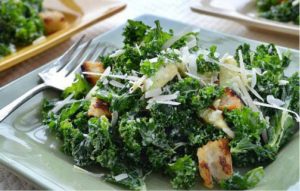In just a couple of decades, the definition of salad has broadened dramatically. When I was growing up, iceberg was about the only head in the case.
My mother later made the leap from iceberg to hearts of romaine, but that’s where her salad journey ended. I’m guessing she’d laugh if I told her people were paying good money for salads made with collards, turnips, mustard greens and kale. For a Southern woman who cooked hearty greens for no less than three hours, my kale Caesar salad might be a hard sell.
Kale has much to recommend it: It’s low-cal and high-fiber with zero fat and lots of iron and calcium (to name just a few of its many benefits). But unless you prepare it properly, eating kale can make you feel a little like a cow chewing cud. To make it more tender, I now do what chefs do — massage the leaves. This technique works for all the dark greens as well as thinly sliced Brussels sprouts, which I also serve in winter salads.
When I first heard the term “massaged kale,” I envisioned hours of carefully rubbing each leaf — but it’s a simple process that transforms thick, rigid leaves into moist, tender greens. First, drizzle the washed, torn kale with a little olive oil as if you’re applying expensive hand cream. With both hands, start rubbing the leaves between your thumbs and your index and middle fingers until the kale has softened in texture and darkened in color (just a few minutes). I’ve found that as long as I don’t season the massaged kale with salt, it will hold at room temperature several hours, and even overnight in the fridge.
At this point the kale is ready to dress, which you can do simply by tossing it with a little extra-virgin olive oil, salt and pepper, followed by a vinegar drizzle and second toss. Of course, you can add other ingredients to the salad — nuts, dried fruits, red onions, apples and olives, for example. My family likes it best when I include homemade garlicky croutons and toss the mix with Caesar dressing.
Serves 4
Slice the bread with a serrated knife, but use heavy-duty kitchen shears to cut the sliced bread into cubes.
- 4 cloves garlic
- 1/4 cup plus 2 teaspoons olive oil, divided
- 2 mounded cups of 3/4-inch bread cubes, cut from a crusty baguette or Italian loaf
- Salt
- 1 bunch (about 8 ounces) curly kale, rinsed, ribs removed and leaves torn into bite-size pieces
- 2 tablespoons lemon juice
- 2-1/2 tablespoons light mayonnaise
- 1/4 teaspoon Worcestershire sauce
- Ground black pepper
- 1/4 cup grated Parmesan cheese (preferably Parmigiano-Reggiano), plus extra for sprinkling
Heat a 10-inch skillet over low heat. Mince garlic cloves in a food processor or blender. Scrape down sides of container and continue to process, adding 1/4 cup of the oil through feeder tube until garlic releases its flavour into the oil, about 30 seconds. Strain garlic from oil through a fine-mesh strainer; reserve both.
Increase skillet to medium. Place bread cubes in medium bowl. Drizzle oil (you lose some of the oil during processing, so you should have about 3 tablespoons) evenly over bread, along with big pinch of salt; toss to coat.
Add bread cubes to hot skillet and toast, turning the cubes and shaking the pan often, until crisp and golden brown, 5 to 7 minutes. Return croutons to bowl and set aside to cool while preparing salad. Whisk lemon juice, mayonnaise, Worcestershire and half the processed garlic in a small bowl. (Reserve remaining garlic for another use.)
Place kale in a medium bowl and drizzle with remaining 2 teaspoons of oil, massaging the torn leaves so they turn soft, shiny and darker in colour. Sprinkle with salt and pepper to taste. Drizzle lemon mixture over kale; toss again.
Sprinkle Parmesan over greens; toss again. Add croutons, toss and serve, sprinkling each portion with a little more Parmesan cheese.





